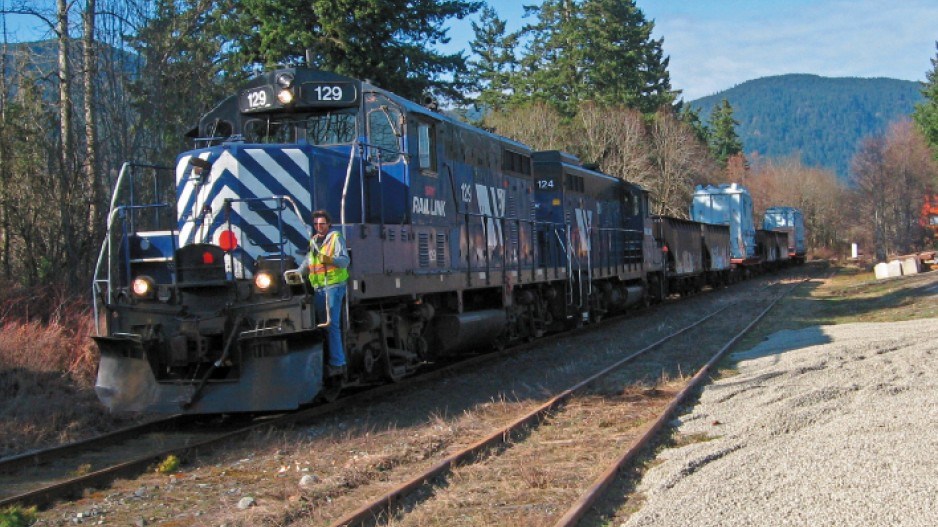Passed from owner to owner for years and teetering on the brink of collapse since last March, Vancouver Island’s historic Esquimalt and Nanaimo (E&N) Railway is again preparing for a comeback.
And while that comeback is initially geared at restoring passenger service, rail proponents are greeting the rail rescue as a coup for Vancouver Island’s future economic development.
“With the way fuel prices are going right now and are projected to go in the future, I believe the Island would be at a serious disadvantage if it did not have a rail connection in the future – it’s that strategic,” said Frank Butzelaar, president of Southern Railway of Vancouver Island Ltd., which operates the railway on behalf of owner the Island Corridor Foundation.
Last March, deteriorated track forced the railway’s owners and operators to suspend passenger operations, slow freight to a crawl, and seriously consider shutting down the railway for good. (See “Vancouver Island rail fights for survival” – issue 1122, April 26-May 2.)
Nor was that the first time the railway has faced closure. After a series of ownership changes starting in the late 1990s, the ICF formed in 2004 to rescue rail when Canadian Pacific Railway decided to leave the struggling business.
The E&N’s latest rescue has come in the form of $15 million in track repair funds from the two senior levels of government. The federal funds just came through this month.
Before launching construction, the ICF still needs to assemble a final $5.4 million for bridge and trestle repair. However, ICF COO Graham Bruce said he’s confident he’ll have that secured by fall.
How big a player could rail be in the Island’s economic future?
“I think it would be a real economic driver,” said Bruce, who added that rail could support the island’s aggregate industry.
“Aggregate for the capital regional district is all shipped in either by barge or it’s trucked in over the Malahat.”
Rail proponents also believe it could play a key role – and gain some significant business – if the proposed Raven Underground Coal Project near Port Alberni is approved.
“At the beginning, it would be about 8,000 rail cars, and it would peak at about 10,000 carloads a year for 16 years,” said Butzelaar.
John Tapics, CEO for the project, told Business in Vancouver that he’s encouraged to see the government’s investment in rail infrastructure but cautioned that the current infusion of funds isn’t geared at coal transport.
“It’s important to remember that repairing the track to allow passenger rail from Victoria to Courtenay doesn’t upgrade the rail bed to the point where it can be used to transport coal,” he said. “Transporting coal by rail to Port Alberni would require significant upgrading of the rail line between Buckley Bay and Port Alberni.”
Port Alberni Port Authority spokesman David McCormick said Port Alberni hasn’t had industrial rail service for a couple of decades.
He said its return, should that happen, would be a key boost for the port.
“Intermodal transportation would be a huge benefit for the port to support the Gateway initiative and potential customers – and to be able to more efficiently serve the markets as we are, as a province and as a nation, expanding into Asia and India-Pakistan.” •
Vancouver Island’s rail saga
1883 Esquimalt and Nanaimo (E&N) Railway incorporated by coal baron Sir Robert Dunsmuir
1886 Sir John A. Macdonald drives last railway spike into the ground
1888 Rail line extended to Victoria
1905 Railway sold to Canadian Pacific Railway (CPR); line extended to Lake Cowichan, Port Alberni, Parksville, Qualicum Beach, Courtenay
1953 CPR discontinues Port Alberni passenger service
1979 Via Rail starts operating E&N Railway; CPR retains land ownership
1998 CPR sells the east-west corridor – Parksville to Port Alberni – to RailAmerica
2001 RailAmerica’s largest client, Norske Canada, decides to truck its freight
2004 Local governments and First Nations form the Island Corridor Foundation (ICF) to preserve the corridor and rail service
2006 RailAmerica ceases operating E&N; CPR donates its 234-km portion of the line to ICF; Southern Railway of Vancouver Island Ltd. becomes ICF’s rail operator
2011 Passenger service suspended due to deteriorated track; ICF petitions for $15 million for repairs and receives $7.5 million from the province
2012 Federal government commits remaining $7.5 million; ICF still looking for $5.4 million for bridge repair, hopes to see passenger service restored in 2013




